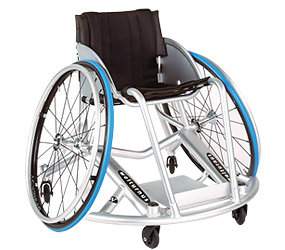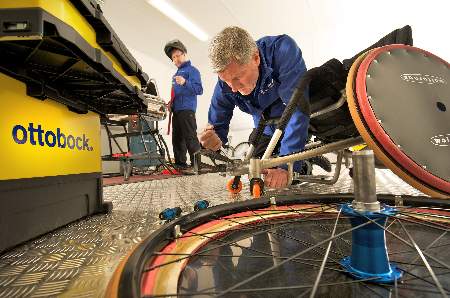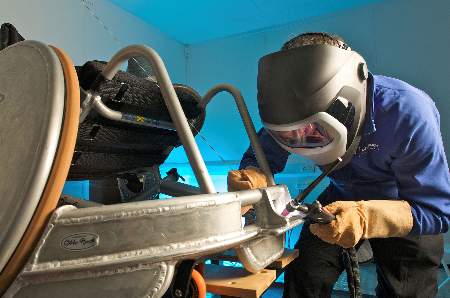For most Olympic athletes, injury is the biggest fear, so they surround themselves with a team of therapists whose job it is to keep their bodies in tip-top condition. But, for Paralympic athletes, it is not just their bodies they have to worry about. For many, the ability to compete at such a high level is reliant on specialist equipment such as wheelchairs, prosthetic limbs and made-to-measure running blades. With such high-tech equipment inevitably comes problems, and at London 2012 solving these technical dilemmas will be the job of an 80-strong team of engineers from mobility equipment giant, Ottobock Healthcare. In this feature, BBH editor, JO MAKOSINSKI, goes behind the scenes of this year’s Paralympic Games to see just what the athletes, and the technical teams, are up against
Imagine you are racing ahead in a Formula One competition and suddenly your brakes fail or your tyre bursts.
In this situation the pit stop is the driver’s best friend - and their only chance of staying in the competition.
When you are taking part in the Paralympic Games, there are three things you want to know; firstly, where is the healthy food? Secondly, where is McDonalds for when you have finished competing? And, lastly, where is the Ottobock workshop?
At this year’s 2012 Paralympic Games in London, the ‘pit stop’ will be provided by Ottobock Healthcare and will have exactly the same crucial role to play in giving the competitors the best chance at a medal spot.
“When you are taking part in the Paralympic Games, there are three things you want to know,” says German Paralympic sprinter, Heinrich Popow. “Firstly, where is the healthy food? Secondly, where is McDonalds for when you have finished competing? And, lastly, where is the Ottobock workshop? It really is vital when you are competing at this level.”
Popow underwent a transfemoral leg amputation when he was just nine years old during treatment for bone cancer. Fearing he would never be able to play sports again, he received an unexpected visit from a man who told him: “You can do everything again. You only have to work a little harder than the others.” This man turned out to be Paralympic racing cyclist, Arno Becker, and his words were enough to start Popow on his own road to sporting success.
“I do sports not in spite of, but because of, my handicap,” he said. “Thanks to sports, I don’t feel handicapped in my daily life either.”
Since his first competition in 2002, he has won a number of key titles including a silver medal in the 100m at the 2008 Beijing Paralympic Games. This year he hopes to take home the gold medal in the same race.
But, like most disabled athletes, and unlike their able-bodied counterparts, Popow needs more than a strict fitness regime to ensure he stands a chance of success at the London 2012 Games. He also needs equipment, in his case a running blade.
Made from carbon fibre, the shape of the blade is designed to enable athletes to efficiently propel themselves forward. Sprinters like Popow have a blade designed for speed and propulsion, while those used by marathon runners are designed for endurance and to be comfortable over long distances.
Ottobock Healthcare, as well as being the official technical partner for the 2012 Paralympic Games, is also one of the biggest manufacturers of mobility aids in the world, supplying healthcare systems around the world, including the NHS.
Its running blade is made from more than 80 layers of carbon, with the exact number dependant on the individual athlete’s amputation, weight and running style. Carbon fibre is used as it is light, flexible and has dampening properties, which means minimal energy is lost through vibration. Carbon fibre also absorbs stress to protect runners’ natural joints from the effects of repetitive impact.
The workshop doesn’t make the athletes go faster, that is all down to their training regime, but it does make it easier for them to compete
On impact the running blade compresses and the power created by the athlete is transferred to the carbon fibre material and this is used to propel the runner forwards. As the pressure is released, the running blade quickly returns to its original shape, returning stored energy to the wearer.
Popow is an ambassador for Ottobock and helps the company to fine tune its technology. He said: “I do not see it as doing disabled sport. I am doing athletics and, thanks to my prosthetic, I feel like I am running with a normal leg. It is not giving me an advantage; the technology is just allowing me to compete.”
This is a view shared by Danny Crates, an Essex-born Paralympic athlete, who is an ambassador for the 2012 Games, despite not being able to compete himself.

The Wolturnus Basket is another Ottobock favourite, designed specifically for wheelchair basketball competitors
A keen rugby player, Crates lost his right arm in an horrific accident while travelling in Australia when he was just 21 years old. Undeterred, he returned to rugby, before taking up sprinting, initially competing in the 400m. He representing England for the first time at the Paralympic Games in Sydney in 2000 and set a new world record when he became Paralympic 800m champion at Athens in 2004.
He told BBH : “One of the things about Paralympic sport is that only a few years ago, one of the guilty pleasures for a spectator was watching the sprinters’ running blades snap and the competitors eat some track. This usually happened on the 200m bend and you would hear the sharp intake of breath from the crowd. You don’t see that happening now, and that is because of the progress made in terms of the equipment athletes now use.”
But it can only go well while the equipment is in good condition, providing the athletes with the support they need. If something goes wrong, their dreams of a spot on the podium are as good as over.
That is where Ottobock’s official partnership with the Paralympic Games comes to the fore.
Since the 1988 competition in Seoul, the company has been responsible for providing technical services to all competitors, regardless of the brand of equipment they are using or where they come from. During this time the team has carried out almost 10,000 repairs; including 2,188 at the last Games in Beijing in 2008.
High-impact sports such as wheelchair rugby keep us very busy and we are prepared for a lot of welding and quick tyre changes at the London 2012 Paralympic Games
With an increase in demand as the technology becomes more advanced, the workforce at the competition has grown from just four engineers and technicians 24 years ago to an 80-strong team that will be available round the clock when the Paralympics comes to London this summer.
The company will have experts from 18 countries, speaking 14 languages and carrying out repairs on orthoses, prosthetics and wheelchairs for all 4,200 competitors. In total there will be three workshops, one in each of the Olympic villages, together with nine in-venue facilities and a mobile centre. The main centre will measure more than 600sq m and will open a week before the games begin to ensure athletes are fully prepared.

Ottobock has been providing technical services to the Paralympic Games since 1988
The centres will be equipped with nine tonnes of specialist equipment which will take two days to unpack. This include 15,000 spare parts and 2,000 wheelchair tyres.
Professor Hans Georg Nader, chief executive of Ottobock and the grandson of the original founder of the company, said: “The role of technology plays a key part in the improvement of all sports, whether it be lighter balls or running blades for Paralympic athletes. As a company we want to provide the very best equipment to support athletes and to ensure the equipment is in the best condition to enable them to compete.”
An example of the impact the repair team can have is seen in the case of young Canadian competitor, Mark Ludbrook, a below-knee amputee who broke his aluminium ankle joint in a training run in the lead-up to the Winter Games in Nagano, Japan, in 1998. After just five hours in the Ottobock workshop, his prosthetic leg was as good as new and he was back on the race course.
And, at the Salt Lake City Winter Paralympic Games in Salt Lake City, Slovakia’s Iveta Chlebakova brought her prosthetic arm to the workshop on the eve of the Giant Slalom. Underneath her cosmetic glove the technicians found the hand had been shattered into countless pieces. Overnight, they worked round the clock to construct a new arm and the next day, Chlebakova scooped the bronze medal.
Crates said: “The workshop doesn’t make the athletes go faster, that is all down to their training regime, but it does make it easier for them to compete.
“The technicians are incredible and can solve any problem. Several years ago I asked them to come up with something that would make it easier for me on the starting blocks. Within a few hours they had produced a prototype using a socket stuck onto a child’s walking stick. This helped me to balance and fell away when the starting pistol went off and I have been using it ever since.
“This sort of innovation is vital and the athletes rely heavily on the team of engineers who are on hand should repairs be needed.”
I do sports not in spite of, but because of, my handicap. Thanks to sports, I don’t feel handicapped in my daily life either
Andrew Parsons, president of the Brazilian Paralympic Committee, added: “Whenever I am with the team competing we make a point of familiarising ourselves with the Ottobock workshop as an essential part of our competition preparations. Their expertise gives Paralympians the confidence that any problems with their equipment will not impact performance. This is especially important for athletes from developing countries who do not always have regular access to experienced technicians at home. Not only that, but the workshops also play an important social role as a meeting point for athletes, coaches and technicians from all around the world.”
These technicians are experts in their particular field, with the 2012 Games team including 12 specialist welders. One of those, Russell Pizzey, who is from the UK, told BBH : “High-impact sports such as wheelchair rugby keep us very busy and we are prepared for a lot of welding and quick tyre changes at the London 2012 Paralympic Games.”

The 80-strong team at the Ottobock repair centre includes 12 expert welders
He will be joined by volunteer, Phillip Calthorpe, from Colchester in Essex, who will bring Tungsten Inert Gas welding experience to the team and will be responsible for repairs such as fixing the damaged aluminium tubing of basketball wheelchairs. Mark Woolsey, a prosthetist from Burton is also volunteering.
To provide more information and showcase the efforts of Paralympic athletes over the years and the advances in technology, Ottobock and the International Paralympic Committee (IPC) have partnered to launch an exhibition which will travel around the country in the build-up to the Games. It will chart the history of the Parlaympic Games and the technologies that help the athletes to compete at the highest level.
This exhibition will give the public a greater understanding of the Games and our athletes, as well as some of the technology our athletes use during competition and in their day-to-day lives
As well as viewing the very latest technologies used by the athletes, visitors will also be able to get interactive and feel for themselves just how strong athletes who use running blades have to be. Plus they will be able to participate in a handcycling speed test.
Sir Philip Craven, president of the IPC, said: “The London 2012 Paralympic Games is set to be the best yet and this exhibition will give the public a greater understanding of the Games and our athletes, as well as some of the technology our athletes use during competition and in their day-to-day lives.”
For more on the exhibition, and the technologies used by the athletes, click here
